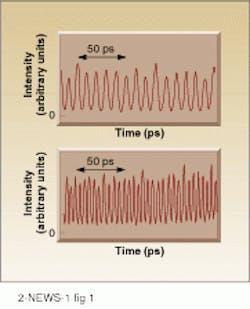The 1996 Optical Fiber Communications conference (OFC, Feb. 25-Mar. 1, San Jose, CA) will present the latest developments in fiberoptic networks, systems, and components. In addition to more than 40 technical sessions, the conference will feature workshops, short courses, tutorial sessions, and commercial-technology sessions that will provide information on state-of-the-art and fundamental technology in the field. "We're migrating the conference toward more applications," says OFC technical cochair Kenneth Hill of the Communications Research Center (Ontario, Canada).
The OFC conference is a cooperative effort between the Optical Society of America, the IEEE Lasers and Electro-optics Society, and the IEEE Communications Society (ComSoc). The Communications Society has tried to bring a systems slant to the meeting based on the view that the art of optoelectronics has reached the point at which the emphasis should shift from device-technology research to network-level development work. "Everybody felt OFC needed more of a systems orientation," says OFC ComSoc steering-committee-member Paul Green. "The IEEE ComSoc role has been to try to bring systems into the spectrum through sessions, tutorials, and short courses. Bit by bit we've been able to get more of a systems flavor into OFC."
As part of the network theme of the conference, the exhibit hall will feature a node connecting to the National Transparent Optical Network (NTON), a four-wavelength, 10-Gbit/s optically switched network developed by the NTON consortium. When completed in two years, the NTON, which is funded by the Advanced Research Projects Agency, will encircle San Francisco Bay, CA, serving as combination technology testbed and optical-network performance showcase. Component and systems-level NTON demonstrations at OFC will include optical switching with acousto-optical tunable filters, remote control and data access, transceiver arrays, and management algorithms for complex, scalable optical networks.
Jim Barksdale of Internet-browser-software-provider Netscape Communications Corp. will address the plenary session. Paul Green says the presentation will present the demand side of the telecommunications industry. The surge in Internet users represents a huge growth in the load on the country's telephone systems, says Green. "These applications are producing a precipitous growth in the demand for bandwidth. Now there's a very real challenge here to exploit the bandwidth of the fiber to meet the explosion in growth." He suggests that this aspect is changing the direction of fiberoptic research. "The raison d'être of researchers presenting at OFC is not just putting fiber into the ground, it's getting the bandwidth out of the fiber that's out there."
Multiplexing splits into several sessions
Four-wave mixing in a semiconductor-laser amplifier can offer polarization-independent, all-optical demultiplexing. Such capabilities will be fundamental to the terabit-rate, all-optical networks of the future. By four-wave mixing the TE and TM modes of a semiconductor-laser amplifier, Toshio Morioka and coworkers at NTT Optical Network Systems (Yokosuka, Japan) have demonstrated demultiplexing at data rates as high as 200 Gbit/s (paper #WH1, see figure).
Fiber-Bragg-grating devices can play a critical role in sensor, telecommunications, and filtering applications. Bragg gratings have been incorporated into Mach-Zehnder interferometers that allow wavelengths to be dropped or added to a communications channel. According to Alan Kersey of the Naval Research Laboratory (Washington, DC), chair of the session on fiber-Bragg-grating devices (#WF), such devices are essentially in-line components that allow the network to selectively drop off one signal without disturbing others, so that the nonredirected signals pass through with very little loss.
Researchers at Mitsubishi Electric Corp. (Osaka, Japan) have used the Mach-Zehnder configuration with a photoinduced Bragg grating to perform add/drop multiplexing in a six-channel, 10-Gbit/s WDM system (paper #WF2). By incorporating chirped Bragg gratings, scientists at the Communications Research Center have applied the approach to multiple-wavelength or broadband communications (paper #WF5).
Add/drop multiplexing in WDM systems can also be accomplished with off-the-shelf components, as demonstrated by researchers at Alcatel CIT (Vélizy, France), who built a four-channel, 10-Gbit/s WDM self-healing ring network with commercially available components (paper #ThD3). Group member Philippe Perrier reports that the dynamically reconfigurable optical add/drop architecture operated successfully over a 270-km network; power loss after 12 signal regenerations and 1080 km of travel was less than 0.3 dB, with a bit-error rate of 10-10.
Network-level technical advances
Bragg gratings act as dispersion-compensation elements in tests performed by scientists at the University of Southampton (Southampton, England) with collaborators at the University of East London (London, England) and BT Laboratories (Ipswich, England). Using a 10-cm-long, chirped, apodized fiber Bragg grating, the group achieved dispersion compensation at 10 Gbit/s over up to 400 km of nondispersion-shifted fiber. Group member R. I. Laming will discuss the experiments and results in paper #ThA5.
Bragg gratings can also be used to flatten the gain of erbium-doped fiber amplifiers (EDFAs), an important operation in telecommunications as gain in these devices is nonuniform as a function of wavelength. Acousto-optic tunable filters, however, are an alternate approach to EDFA gain equalization, as researcher S. H. Huang of the University of Southern California (Los Angeles, CA) will report (paper #WM6). Offering independent control of multiple passbands, these filters can be set in an active feedback loop to provide dynamic equalization of amplifier gain.
By depolarizing the optical carrier in a test network via scrambling the polarization state of the launched optical signal, scientists at AT&T Bell Laboratories (Holmdel, NJ) have demonstrated
100-Gbit/s data transmission over transoceanic distances. Twenty WDM channels operating at 5 Gbit/s successfully carried data across 6300 km of optical fiber. AT&T researcher Neal Bergano will describe this system, including the use of superimposed phase modulation to improve data quality (paper #TuN).
About the Author
Kristin Lewotsky
Associate Editor (1994-1997)
Kristin Lewotsky was an associate editor for Laser Focus World from December 1994 through November 1997.
